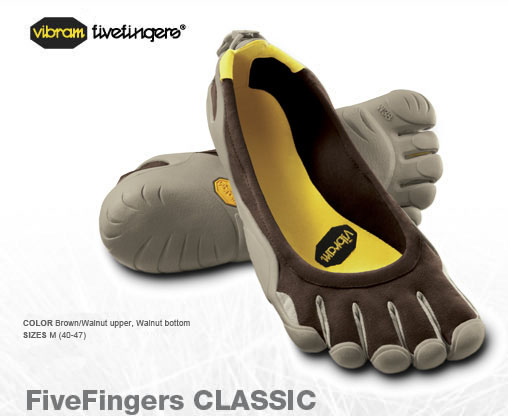I’ve been lucky enough to work with the best hockey players on the planet in my time working in the National Hockey League. Now, it’s my mission to help deliver the same type of training that helped those players stay fast and strong to anyone and everyone that is willing to put in the work. I recently launched an online training option so that I can reach and impact hockey players around the globe and you can actually sign up below.
“Bantam Back” is a description of a lumbar stress fracture in youth hockey players. For those unfamiliar, Bantam refers to hockey players ages 13-15 years old. Basically, it is Spondyloylsis which is a stress fracture in the pars interarticularis of the lumbar vertebrae which is a small bone joining 2 vertebrae. These fractures can happen from repetitive stress.
Unfortunately, this condition has been popping up frequently in recent years. I first heard of this condition from John Bottoms, a Minneapolis based Physical Therapist. The frequency of how many kids are in his clinic for this shocked me. What can strength and conditioning coaches do during the reconditioning process and what can they do to help prevent them from happening in the first place?
https://orthoinfo.aaos.org/en/diseases–conditions/spondylolysis-and-spondylolisthesis/
From my personal observation, the typical Bantam Back individual is a longer/taller player. They also may have recently had a growth spurt. I imagine it could happen with shorter players but from what I have seen, they’ve been on the taller side. They also play hockey on a year-round basis.
Although I do think that repetitive rotation in shooting is a contributing factor, I also believe that improper skating technique contributes. Specifically, when skating mechanics break down (“bag” skating or punishment skating after practices). This is where players can become more straight-legged versus maintaining a proper back position and knee bend. I also believe that there is an inability for coaches and players to determine the proper depth and technique for skaters. I think we can get confused when teaching taller players to get low while skating. For example, a taller player may not look low in comparison to smaller players. However, when you take hip and knee angles into consideration, they may be closer than you think. I believe that the stress in the back is higher for taller players who maybe coached to get lower. When you add in repetitive and useless conditioning drills- the outcome isn’t good.
The prescription when diagnosed with Bantam Back is 3 months of no activity. However, physical therapy can begin during that time. This is crucial so that the fracture can heal while also removing any activities that may have helped caused the injury in the first place. In the recovery process, the no activity prescription is strict. Some orthopedic specialists may recommend a back brace during the 3 months.
What can happen is that people don’t listen to the doctor’s advice. Maybe the player is diagnosed during the competitive season? Maybe a showcase that is heavily scouted is coming up? It doesn’t matter. The 3 months off is key. I understand that this isn’t good news but I look at it as a time to reset and refocus on some things before returning to the ice. The payoff is bigger in the long run.
The treatment plan at the beginning consists of low level core exercises and stretches specifically for the hamstrings and hip flexors. The progression gradually becomes challenging from low level to more functional applications so that the player can return to the ice. Usually, the rehabilitation combined with the 3 months of rest results in a positive outcome.
What can Strength and Conditioning Coaches do to help these situations and what can they do to help prevent from them happening?
Although I don’t think it is appropriate, year-round hockey is normal nowadays. Players have more opportunities to play outside of the winter hockey season. It is important to participate in other sports and/or recreational activities. I think that the time off the ice and away from hockey is important. When I think about the professional players that I get to work with, they take a minimum of 1 month off of the ice when the season ends. When they do return to the ice, the intensity and duration is progressed over the next few months up until training camp. Bantam aged players are not professionals. Their bodies are still maturing. I think the 3-month activity is a blessing for those who suffer from bantam back.
When it comes to exercises and progressions, I think it’s important to note that I am not a Physical Therapist (PT). I do help with the reconditioning of athletes. I also use exercises that PT’s will use with injured athletes with the healthy athletes that I work with. I truly believe that if a PT prescribes exercises with an injured client, why wouldn’t I want to prescribe exercises with a healthy athlete to help prevent injuries? Whether it is core exercises, pre-habilitation, or functional training- I really don’t care. As long as what we are doing is working and we are simultaneously getting faster, powerful, and stronger.
Where I think the Strength and Conditioning Coach is important is in the return to play phase and then helping the player with preventing this from happening again. When it comes to program design, I think that some modifications need to be made. Avoiding exercises that could promote hyperextension of the lower back while under load could help as well as avoiding axial loading. For example, back squats, front squats, overhead pressing, deadlifting, and Olympic lifting would be discontinued. I do think that there are many ways for an athlete to get more powerful, stronger, and faster without risking further injury.
The Mcgill Torso Muscular Endurance Test Battery (1) is used as an assessment to measure endurance in the trunk flexors, lateral endurance (side bridge), and the back extensors. This can be used as a baseline measurement at the beginning of rehab. During the course of the 3 months, this can be reassessed to see progress.
When it comes to core training, I do think improving performance of the Mcgill Torso Muscular Endurance Test Battery helps. McGill’s Big 3 (2) is a really good safe and simple way to increase not only performance in the Endurance test, but also a way to build a strong and stable back with endurance capabilities. We’ve removed what others refer to as traditional core training and have since been incorporating the Trunk Curl Up, the Side Bridge, and the Bird Dog as well as Glute Bridges for our floor-based exercises.
TRUNK CURL UP
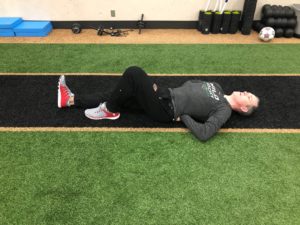
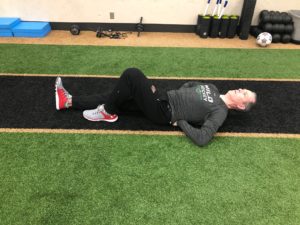
SIDE BRIDGE
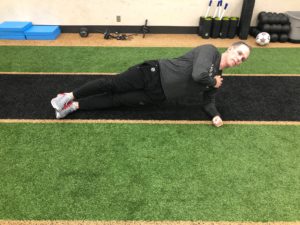
BIRD DOG
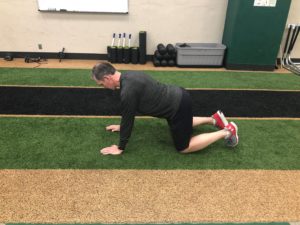
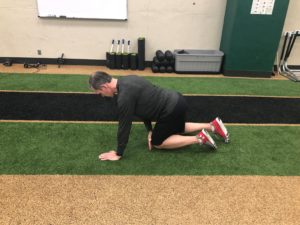
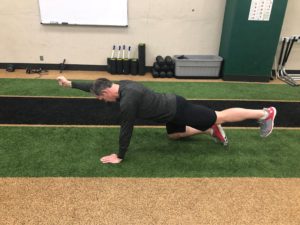
What about Skating? As I mentioned before, I believe that less than adequate skating technique can contribute to Bantam Back. I think that after the 3-month long break, the player needs to be with a good skating coach to help the player possibly re-learn skating technique. The fundamental position of skating needs to be emphasized so that lower back health isn’t compromised. This combined with proper strength and conditioning off the ice can contribute to the player returning back to their normal level of play. I have personally seen kids come back to skate and play again at a higher level.
Again, sometimes an injury like this can be a blessing in disguise. It may sound crazy, but it is 3 months forced rest. Unfortunately, some kids need that today. A young athlete competing year round combined with less attention to technique can be as a recipe for something like this.
- https://www.acefitness.org/cmes-resources/pdfs/02-10-CMES-McGillsTorsoEnduracneTest.pdf
- https://www.livestrong.com/article/392341-stuart-mcgills-big-three-back-exercises/
In the next post, of our “What To do If Your Glutes Are Weak” series, I want to cover our glute activation exercises and progressions.
After we have foam rolled and stretched the hip flexors, we will then activate the glutes. It is important to note that although I broke this down into a 3-part series, the time it takes to complete all 3 steps takes about 5-10 minutes. It is not that long of time considering that during the rest of the day, most athletes and clients are doing activities that can make the dysfunction worse.
Hopefully now since the hip flexors are lengthened, we can now get some quality contraction out of the glutes. The first exercise we go to is the Double Leg Glute Bridge. Here we are asking our athletes to squeeze their glutes together to create the action of hip extension. Some of the coaching cues that we use here include getting our athletes to brace their core which would prevent lumbar extension and driving their heels into the ground. We will do 10 reps of :03 hold.
Double Leg Glute Bridge
Another exercise that we will do during this phase is the Quadruped Bent Knee Hip Extension. While in a quadruped position, we are trying to get our athletes to use their glute on one leg to great hip extension. We don’t want any lumbar extension- just hip extension. We start with 5 reps on each leg with a :03 hold.
Quadruped Alternating Leg Bent Knee Hip Extension
Ultimately, we always continue to progress to more advanced versions of each exercise for our Glute Activation progressions. For example, we will progress from the Double Leg Glute Bridge to Cook Hip Lift, to Hands Free Single Leg Hip Extension. For the Quadruped progressions, we progress to Straight Leg Hip Extension, to Opposite Arm/Leg Extensions, to Resisted Opposite Arm/Leg Extension. The opportunities to progress and make these more difficult are endless.
It is important to note that these are for activation exercises only. These are not exercises we would use within a strength training session. Those exercises would include squatting variations and dead lifting variations to help us strengthen our entire posterior chain including the glutes. I am a believer that if the glutes aren’t turned on, then the other muscles in the posterior chain will take over and compensate for the weak glute(s). Thanks for reading!
Also, check out the Interviews page which include some interviews that I have done in audio format and a new recent article that was in the Orange County Register.
Hey Everyone,
Hope you are doing well and having a great summer. We have been
busy adding a ton of content every week and we wanted to make
sure you are caught up with all of it.
Newest Videos:
Slide Board Progressions- Darryl Nelson:
http://www.hockeystrengthandconditioning.com/members/Slide_Board_Progression_Videos.cfm
Three Stage Hip Flexion Progression- Michael Boyle
http://www.hockeystrengthandconditioning.com/members/Video_of_the_Week_Three_Stage_Hip_Flexion_Progression.cfm
Soft Tissue Work: Posterior Adductor Magnus- Kevin Neeld
http://www.hockeystrengthandconditioning.com/members/Video_of_The_Week_Soft_Tissue_Work_Posterior_Adductor_Magnus.cfm
Incorporating The Crossover Step In Speed Training For Hockey-
Sean Skahan
http://www.hockeystrengthandconditioning.com/members/Video_of_the_Week_Incorporating_The_Crossover_Step_In_Speed_Training_For_Hockey.cfm?sd=50
Also, we have posted Matt Nichol’s presentation “Energy Systems
Development for Ice Hockey” from “Second Annual Boston Hockey
Summit and Basketball Symposium”.
Check it out at:
http://www.hockeystrengthandconditioning.com/members/quotEnergy_Systems_Development_for_Ice_Hockeyquot.cfm
If you want to get the Summit on DVD, including Sean Skahan’s
presentation, go to
http://www.bsmpg.com/purchase-previous-conference-videos/
Latest Articles:
Managing the End of a Hockey Season- Mike Potenza
http://www.hockeystrengthandconditioning.com/members/Managing_the_End_of_a_Hockey_Season.cfm
Getting Your Athletes On Board Your Bus- Sean Skahan
http://www.hockeystrengthandconditioning.com/members/Getting_Your_Athletes_On_Board_Your_Bus.cfm
Why Not Play on the Best Team?- Mike Boyle
http://www.hockeystrengthandconditioning.com/members/Why_Not_Play_on_the_Best_Team.cfm
Latest Programs:
Upper Body Injury Program- Sean Skahan
http://www.hockeystrengthandconditioning.com/members/Upper_Body_Injury_Program.cfm
Off-Season Conditioning- Mike Potenza
http://www.hockeystrengthandconditioning.com/members/OffSeason_Conditioning.cfm
Thanks again to all of you who have been participating on the
Coaches Forum. There have been some great discussions:
Hockey Speed vs. Foot Speed
http://www.hockeystrengthandconditioning.com/members/cfmbb/messages.cfm?threadid=1ED94582-24E8-5ED2-F1C37D8B89CDCC29
Question about the DB Complex video
http://www.hockeystrengthandconditioning.com/members/cfmbb/messages.cfm?threadid=87F524B3-24E8-5ED2-F18DEA06566D8A88
Slide Board Length Variations
http://www.hockeystrengthandconditioning.com/members/cfmbb/messages.cfm?threadid=815AC9CC-24E8-5ED2-F1711495303D9250
If you have any questions, let us know.
Michael, Sean, Mike and Kevin
The next thing that we do in our “What to do with inhibited glutes” series is our stretching protocol. This would be done right after foam rolling. Since the hip flexors are antagonistic to the glute max, we will continue to try and lengthen and relax these muscles.
If you have a partner to stretch you, or if you are the trainer/strength and conditioning coach, and your client needs to stretch their hip flexors, the modified Thomas Position is where to start. In our situation, if we are stretching before a training session or a practice, we will do the Active Isolated Method of stretching. If an athlete requests it, we will manually stretch them out on a table. We will also use the self-static stretch variation as well before and after practices and/or during workouts. During the AIS method, we are cueing our athlete to think about contracting the glute as we try to lengthen the hip flexors a little more each rep.
Thomas Position Hip Flexor A.I.S.
Thomas Position Hip Flexor + Rectus Femoris A.I.S.
Sometimes we will incorporate prone hip flexor stretching. I’ve found this one helpful for athletes who may have some back pain in conjunction with inhibited glutes. Like the modified Thomas Position stretch, we are cueing our athlete to contract the glute on the top of the movement.
Prone Hip Flexor + Rectus Femoris
 I am excited to be a part of the 11th annual College of the Canyons Strength and Conditioning Clinic. Rober Dos Remedios puts on an outstanding seminar every year and I am honored to be a part of this year. My talk will be on Hockey Conditioning. If you are in the area, check it out.
I am excited to be a part of the 11th annual College of the Canyons Strength and Conditioning Clinic. Rober Dos Remedios puts on an outstanding seminar every year and I am honored to be a part of this year. My talk will be on Hockey Conditioning. If you are in the area, check it out.
There are several strength and conditioning coaches and trainers who prescribe isolated glute max muscle “activation” and/or strengthening work. These are exercises such as glute bridges, 1-leg glute bridges, quadruped hip extensions, and others where the emphasis is on the quality of the muscle contraction. There are also several coaches and trainers who think that activation exercises are a waste of time and think that this concept is just a fad. What I have found is that they may think that if their athletes are doing exercises such as squats, lunges, single leg squats, split squats, etc, then they are strengthening their glutes and the activation exercises are unnecessary. I am one who does prescribe glute activation exercises. We will do glute max isolation exercises on a daily basis with our players.
First, I think it is imperative to note that my job is to help keep the best players in the lineup on a nightly basis. I understand that injuries such as fractures, concussions, and lacerations are beyond my control. However, I am on the cautious side when it comes to soft tissue injuries. We will do everything that we possibly can to help prevent injuries from happening- even with healthy athletes.
I was first introduced to the Prone Hip Extension Test by Al Vermeil at a seminar we hosted at Boston College back in 2001. A few years later, I was able to attend a course on the Janda Method. That’s when I learned how to administer the test properly. This test has helped us identify athletes who don’t use their Gluteus Max’s when completing hip extension movement. In a proper sequence of muscle activation, the hamstrings would fire first, glute max second, opposite side lumbar extensors third, same side lumber extensors fourth, opposite thoracolumbar extensors fifth, and same side thoracolumbar extensors sixth. Several times, the gluteus maximus may not turn on at all. Sometimes, we will see a difference in right vs. left side function. In my opinion; this is a recipe for disaster. Players who are continually going out and performing in their sport with this kind of pattern have a good chance of getting hurt. Lower backs, hip flexors, and groins, can be affected by this. Think about it, a player who can’t fire his glute max in order to help produce a significant amount of hip extension is going to find a way to do it without them. Hamstrings, and lower back are the likely candidates. These muscles may over work and strain. I would also be worried about the athletes who are doing squats, lunges, single leg squats, and split squats, with this weakness too. They are figuring out a way to do those exercises without their glute max.
We added some great content this week on HockeyStrengthandConditioning.com.:
– “Shopping For the Right “Dryland” Training Program” from Mike Potenza.
As the summer gets closer, parents and young hockey players will hear about many camps and programs available for off-ice training. Shopping for the right “Dryland” training program can be made easier by asking a few questions. Coach Potenza lists what questions to ask and why to ask them.
– Answering to a forum post, Jaime Rodriguez shows sled variations at Mike Boyle Strength and Conditioning for the Video of the Week.
– Sean Skahan breaks down 4 phases of “In-Season Core” work.
Also, the Coaches Forum is jumping. Lots of great discussion already, including “Testing Hockey Players”. Find out the answers to:
- What are the best tests to use in the beginning of the season for college and pro hockey players to determine anaerobic capacity, power, and strength.
- Does anybody have their players perform the test multiple times during the season and post season to compare the strength and conditioning to the pre-season?
Hope you all are enjoying the site. Any questions let us know.
Michael, Sean, Mike, and Kevin.
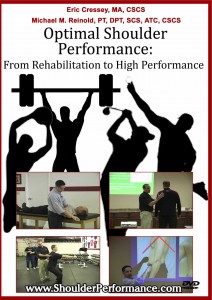 Eric Cressey and Michael Reinold have released a 4 DVD set of a seminar that they did back in November. These are 2 smart guys who have the ability to apply their knowledge to some of the best players in baseball. In my coaching situation, bridging the gap between athletes looking to get healthy and athletes looking to stay healthy is what it’s all about. Check it out – Optimal Shoulder Performance
Eric Cressey and Michael Reinold have released a 4 DVD set of a seminar that they did back in November. These are 2 smart guys who have the ability to apply their knowledge to some of the best players in baseball. In my coaching situation, bridging the gap between athletes looking to get healthy and athletes looking to stay healthy is what it’s all about. Check it out – Optimal Shoulder Performance
1- HockeyStrengthandConditioning.com is up and running. If you train hockey players, you have to check it out. We will start posting content on a weekly basis real soon. I am really excited about it as there are several strength and conditioning coaches and athletic trainers from all levels including the NHL, AHL, major junior, and others.
2- I got a pair of Vibram Five Fingers a few weeks ago. Honestly, I wish I got them sooner. I’ve been training with them and have been on a few walks with them. I believe they have helped me with some neurological symptoms that I have had in my left foot. Surgery for a bulging disk back in 1999, and another surgery that I had to remove a non-cancerous mass in my spinal cord at the cervical level, has given me trouble with sensation. I really believe that the Vibrams have helped wake up some proprioceptors and muscles that may have been shut down in my foot. I am actually able to move my pinky toe by itself. Something I haven’t been able to do for a long time.
3- Another thought on my training, I really love Jim Wendler’s 5-3-1 program. I continue to make gains in strength on this program as I keep going up on my Military Press and Bench Press. My “Actual Max” has gone from 155 to 190 in the Military Press while my Bench has gone from 225 to 265. (I do not squat or deadlift, see #2 above). Not bad results. Something I may look into with my junior hockey players this summer. What I really like about it is the simplicity of it. It is a basic program that is really easy to plan out.


